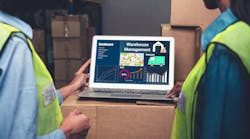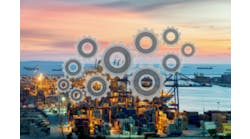It’s safe to say artificial intelligence (AI) is one of history’s most disruptive innovations. While its widespread use is relatively recent, it’s already changing industry after industry. It’s only a matter of time before AI package delivery and fleet optimization become standard in the logistics sector.
Despite AI’s vast promise, it’s just a tool. If businesses hope to profit from it, they must know how to use it. In that spirit, here are seven ways AI can improve package delivery.
1. Route Optimization
Route optimization software is the most well-known application of AI in package delivery. It’s also among the most impactful.
Choosing the right route heavily affects fuel efficiency, delivery times and truck mileage, but it’s difficult to do so manually. There are too many complex factors to weigh, especially when considering real-time changes like traffic and the weather. However, AI thrives in this kind of decision-making.
AI navigation software can find the optimal route for each delivery faster and more accurately than non-AI alternatives. Perhaps the most famous example is UPS’s ORION platform, which saved the company 10 million gallons of fuel annually by finding more efficient routes. While ORION is a proprietary system, similar off-the-shelf solutions are becoming more popular, making this AI application more accessible.
2. Load Optimization
A newer but similarly beneficial AI-driven approach is to right-size outgoing loads with AI. Vehicles often leave warehouses before reaching their full capacity, leading to extra trips and increased fuel spending. AI can help by determining which packages should go in which truck—even suggesting how to pack them—to enable more efficient loading.
Maximizing a vehicle’s load capacity entails many small, easy-to-miss details. For example, some roof racks can hold up to 250 pounds per bar, so if teams don’t secure goods on the roof, they’re not using all available space. AI is better at complex problem-solving, so it’s the ideal solution to this issue.
On top of finding strategies humans may miss, AI load optimization software works faster than people would. As a result, fleets don’t have to sacrifice delivery time for more cost-effective loading practices.
3. Fleet Maintenance Tracking
Maintenance is another advantageous area of AI fleet management. Most fleets understand the need for an effective maintenance strategy, but creating and sustaining one is often challenging. AI can manage these complex considerations to make it easier.
Artificial intelligence can deliver maintenance improvements in two main ways. The first is through predictive maintenance, where it analyzes vehicle health factors to determine when they need repairs. Applying this practice avoids unneeded fixes—which account for 30% of all maintenance activities—while minimizing breakdown risks.
The other way AI improves vehicle care is by tracking fleet-wide patterns and trends. It can analyze repair data from all a fleet’s vehicles to remind businesses when to perform some fixes, alert them of rising costs or suggest when it’s time to replace a truck.
4. Inventory Balancing
AI package delivery practices can apply to non-vehicle-related operations, too. Some businesses have started using it to gauge demand shifts in different locations. The software then recommends how much of each item to store in which warehouses for faster shipment.
E-commerce giant Amazon applied this approach ahead of Black Friday 2023. Its deep learning platform forecasts demand for 400 million products down to the specific day. As a result, some of the company’s facilities were able to prep orders for shipment within 11 minutes of ordering.
Balancing inventory across locations is becoming increasingly important as consumer expectations for delivery times grow. Today’s customers expect remarkably fast windows, but supply chains are often too complex to support these speeds without insight into the future. Predictive models provide that glimpse on a previously impossible level.
5. Mitigating Warehouse Labor Shortages
Of course, a drop in productivity can make even a perfectly stocked warehouse struggle to support faster deliveries. Ongoing labor shortages do just that, but AI can once again provide a solution.
Automated robots can handle the entire picking process, removing one of the least-efficient tasks from employees’ workflows. Other facilities use machine vision to let robotic arms help workers load trucks more efficiently. Even if this automation doesn’t eliminate manual work, it reduces it, mitigating the impact of labor shortages.
AI can also create and analyze digital twins of a warehouse—virtual representations of the real-world facility. This analysis highlights where workflows can change to become more efficient, offsetting lost productivity from hiring gaps.
6. Package Theft Prevention
One of the newest ways AI is transforming logistics in the last mile is through theft prevention. As e-commerce has risen, so has the issue of “porch pirates”—people stealing packages from their buyers’ doorsteps. Some businesses are now trying to fight back through AI-driven insights.
Companies like Costco and UPS are testing predictive models that score delivery addresses on the likelihood of porch piracy. If the model decides a delivery has a high chance of getting stolen, it’ll recommend an alternate pickup location to the buyer.
While this system isn’t a perfect fix, it informs shoppers of potential risks and offers a safer alternative. That way, logistics companies lessen their liability in the case of a stolen delivery and customers can protect their purchases.
7. Sustainability Improvements
AI in package delivery can also make logistics services more sustainable. The logistics and transportation sector produces the most CO2 emissions of any industry, but AI makes it easier to set and reach environmental goals.
Many AI fleet management applications have secondary environmental benefits. Load and route optimization, for example, lower emissions by reducing the time vehicles spend on the road. Beyond that, analytics models can determine where a fleet’s carbon footprint could improve and suggest actionable steps to improve it.
Sustainability is complicated, especially considering third-party emissions and carbon offsets. AI can make sense of this complex data so it’s easier for key stakeholders to understand. Once businesses recognize where they stand, they can craft more effective sustainability initiatives.
AI Is Transforming Logistics for the Better
These seven examples are just a sample of the ways AI can transform package delivery and logistics. Like all technologies, these models will only become better over time, too. That potential will undoubtedly push the industry toward a brighter future.
Organizations must capitalize on these benefits to use them to their fullest, as AI will likely become an industry standard before long. Learning where it’s most valuable now helps companies get ahead of the curve.









